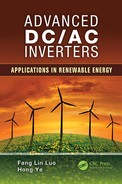This book provides knowledge and applications of advanced DC/AC inverters that are both concise and useful for engineering students and practicing professionals. It is well organized in about 300-plus pages and with 250 diagrams to introduce more than 100 topologies of the advanced inverters originally developed by the authors. Some cutting-edge topologies published recently are also illustrated in this book. All prototypes are novel approaches and great contributions to DC/AC inversion technology.
DC/AC inversion technology is one of the main branches in power electronics. It was established in the 1960s and grew fast in the 1980s. DC/AC inverters convert DC power sources to AC power users. It is of vital importance for all industrial applications, including electrical vehicles and renewable energy systems. In recent years, inversion technology has been rapidly developed and new topologies have been published, which largely improved the power factor and increased the power efficiency. One purpose of writing this book is to summarize the features of DC/AC inverters and introduce more than 50 new circuits as well.
DC/AC Inverters can be sorted into two groups: pulse-width modulation (PWM) inverters and multilevel modulation (MLM) inverters. People are familiar with PWM inverters, such as the voltage source inverter (VSI) and current source inverter (CSI). They are very popular in industrial applications. The impedance-source inverter (ZSI) was first introduced in 2003 and immediately attracted many experts of power electronics to this area. Its advantages are so attractive for research and industrial applications that hundreds of papers regarding ZSI have been published in recent years.
All PWM inverters have the same main power circuits, that is, three legs for three-phase output voltage. Multilevel inverters were invented in the 1980s. Unlike PWM inverters, multilevel inverters have different main power circuits. Typical ones are the diode-clamped inverters, capacitor clamped (flying capacitor) inverters, and hybrid H-bridge multilevel inverters. Multilevel inverters overcame the drawbacks of the PWM inverter and opened a broad way for industrial applications.
This book introduces four novel multilevel inverters proposed by the authors: laddered multilevel inverters, super-lift modulated inverters, switched-capacitor inverters, and switched-inductor inverters. They have simple structures with fewer components to implement the DC/AC inversion. They are very attractive to DC/AC inverter designers and have been applied in industrial applications, including renewable energy systems.
This book introduces four methods to manage the switching angles to obtain the lowest THD, which is an important topic for multilevel inverters. The half-height (HH) method is superior to others in achieving low THD by careful investigation. A MATLAB® program is used to search the best switching angles to obtain the lowest THD. The best switching angles for any multilevel inverter are listed in tables as convenient references for electrical engineers. Simulation waveforms are shown to verify the design.
Due to world energy resource shortage, the development of renewable energy sources is critical. The relevant topics such as energy-saving and power supply quality are also paid much attention. Renewable energy systems require large number of DC/DC converters and DC/AC inverters. In this book, introduction and design examples including analysis and results are given for wind turbine and solar panel energy systems.
The book is organized in 15 chapters. General knowledge is introduced in Chapter 1. Traditional PWM inverters, such as voltage source inverters, current source inverters, and impedance source inverters, are discussed in Chapters 2 to 5. New quasi-impedance source inverters and softswitching PWM inverters are investigated in Chapters 6 and 7, respectively. Multi-level DC/AC inverters are generally introduced in Chapter 8. Trinary H-bridge inverters are specially investigated in Chapter 9. Novel multilevel inverters including laddered multilevel inverters, super-lift modulated inverters, switched capacitor inverters, and switched inductor inverters are introduced in Chapters 10 to 13. Best switching angles to obtain lowest THD for multilevel DC/AC inverters are studied in Chapter 14. Application examples in renewable energy systems are discussed in Chapter 15.
Professor Fang Lin Luo
AnHui University HeFei, China
Doctor Hong Ye
Nanyang Technological University Singapore
